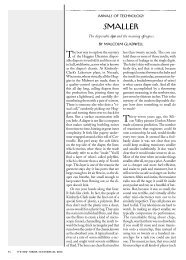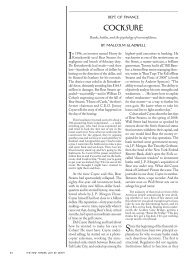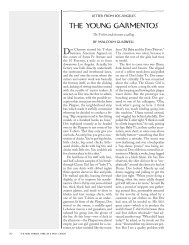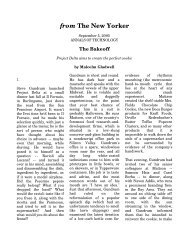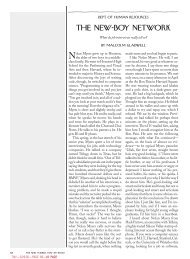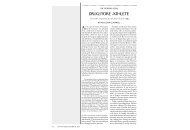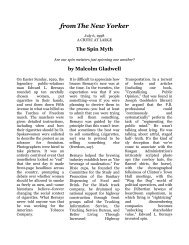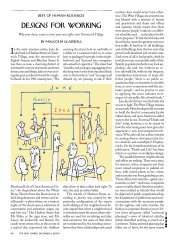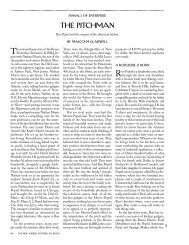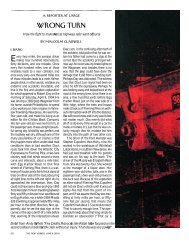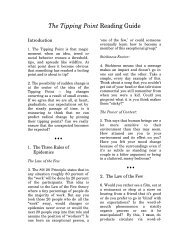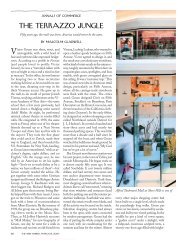iN THE AiR - Malcolm Gladwell
iN THE AiR - Malcolm Gladwell
iN THE AiR - Malcolm Gladwell
You also want an ePaper? Increase the reach of your titles
YUMPU automatically turns print PDFs into web optimized ePapers that Google loves.
super-thermoses, so you wouldn’t need<br />
refrigerators for certain things. They also<br />
came up with this idea to stop hurricanes.<br />
Basically, the waves in the ocean have energy,<br />
and you use that to lower the temperature<br />
differential. I’m not saying it necessarily<br />
is going to work. But it’s just an<br />
example of something where you go,<br />
Wow.”<br />
One of the sessions that Gates participated<br />
in was on the possibility of resuscitating<br />
nuclear energy. “Teller had this<br />
idea way back when that you could make<br />
a very safe, passive nuclear reactor,”<br />
Myhrvold explained. “No moving parts.<br />
Proliferation-resistant. Dead simple.<br />
Every serious nuclear accident involves<br />
operator error, so you want to eliminate<br />
the operator altogether. Lowell and Rod<br />
and others wrote a paper on it once. So<br />
we did several sessions on it.”<br />
The plant, as they conceived it, would<br />
produce something like one to three gigawatts<br />
of power, which is enough to serve<br />
a medium-sized city. The reactor core<br />
would be no more than several metres<br />
wide and about ten metres long. It would<br />
be enclosed in a sealed, armored box. The<br />
box would work for thirty years, without<br />
need for refuelling. Wood’s idea was that<br />
the box would run on thorium, which is a<br />
very common, mildly radioactive metal.<br />
(The world has roughly a hundred-thousand-year<br />
supply, he figures.) Myhrvold’s<br />
idea was that it should run on spent fuel<br />
from existing power plants. “Waste has<br />
negative cost,” Myhrvold said. “This is<br />
how we make this idea politically and regulatorily<br />
attractive. Lowell and I had a<br />
monthlong no-holds-barred nuclearphysics<br />
battle. He didn’t believe waste<br />
would work. It turns out it does.” Myhrvold<br />
grinned. “He concedes it now.”<br />
It was a long-shot idea, easily fifteen<br />
years from reality, if it became a reality at<br />
all. It was just a tantalizing idea at this<br />
point, but who wasn’t interested in seeing<br />
where it would lead? “We have thirty<br />
guys working on it,” he went on. “I have<br />
more people doing cutting-edge nuclear<br />
work than General Electric. We’re looking<br />
for some one to partner with us, because<br />
this is a huge undertaking. We<br />
took out an ad in Nuclear News, which is<br />
the big trade journal. It looks like something<br />
from The Onion: ‘Intellectual Ventures<br />
interested in nuclear-core designer<br />
and fission specialist.’ And, no, the F.B.I.<br />
hasn’t come knocking.” He lowered his<br />
voice to a stage whisper. “Lowell is<br />
known to them.”<br />
It was the dinosaur-bone story all over<br />
again. You sent a proper search team into<br />
territory where people had been looking<br />
for a hundred years, and, lo and behold,<br />
there’s a T. rex tooth the size of a banana.<br />
Ideas weren’t precious. They were everywhere,<br />
which suggested that maybe the<br />
extraordinary process that we thought<br />
was necessary for invention—genius, obsession,<br />
serendipity, epiphany—wasn’t<br />
necessary at all.<br />
In June of 1876, a few months after he<br />
shouted out, “Mr. Watson, come<br />
here,” Alexander Graham Bell took his<br />
device to the World’s Fair in Philadelphia.<br />
There, before an audience that included<br />
the emperor of Brazil, he gave his<br />
most famous public performance. The<br />
emperor accompanied Bell’s assistant,<br />
Willie Hubbard, to an upper gallery,<br />
where the receiver had been placed, leaving<br />
Bell with his transmitter. Below<br />
them, and out of sight, Bell began to talk.<br />
“A storm of emotions crossed the Brazilian<br />
emperor’s face—uncertainty, amazement,<br />
elation,” Charlotte Gray writes.<br />
“Lifting his head from the receiver . . . he<br />
gave Willie a huge grin and said, ‘This<br />
thing speaks!’ ” Gray continues:<br />
Soon a steady stream of portly, middleaged<br />
men were clambering into the gallery,<br />
stripping off their jackets, and bending their<br />
ears to the receiver. “For an hour or more,”<br />
Willie remembered, “all took turns in talking<br />
and listening, testing the line in every possible<br />
way, evidently looking for some trickery, or<br />
thinking that the sound was carried through<br />
the air. . . . It seemed to be nearly all too wonderful<br />
for belief.”<br />
Bell was not the only one to give a<br />
presentation on the telephone at the<br />
Philadelphia Exhibition, however.<br />
Someone else spoke first. His name was<br />
Elisha Gray. Gray never had an epiphany<br />
overlooking the Grand River. Few<br />
have claimed that Gray was a genius. He<br />
does not seem to have been obsessive, or<br />
to have routinely stayed up all night while<br />
in the grip of an idea—although we don’t<br />
really know, because, unlike Bell, he has<br />
never been the subject of a full-length biography.<br />
Gray was simply a very adept<br />
inventor. He was the author of a number<br />
of discoveries relating to the telegraph industry,<br />
including a self-adjusting relay<br />
that solved the problem of circuits sticking<br />
open or shut, and a telegraph<br />
printer—a precursor of what was later<br />
called the Teletype machine. He worked<br />
closely with Western Union. He had a<br />
very capable partner named Enos Barton,<br />
with whom he formed a company<br />
that later became the Western Electric<br />
Company and its offshoot Graybar (of<br />
Graybar Building fame). And Gray was<br />
working on the telephone at the same<br />
time that Bell was. In fact, the two filed<br />
notice with the Patent Office in Wash-



